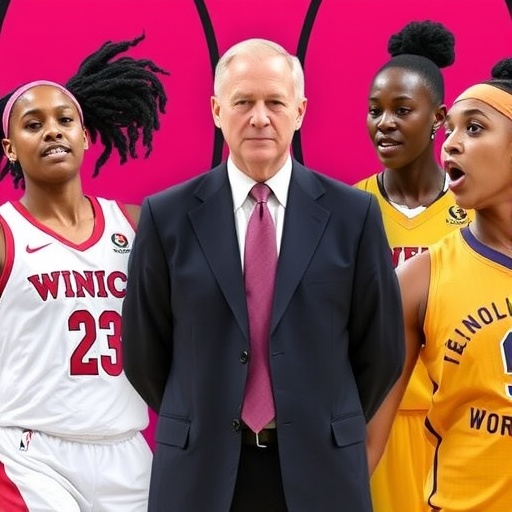WNBA Players Poised for Major Salary Increases in Upcoming CBA, Adam Silver Announces
In a groundbreaking revelation for women’s basketball, NBA Commissioner Adam Silver has confirmed that WNBA players can anticipate substantial salary hikes as part of the league’s forthcoming collective bargaining agreement (CBA). Speaking at a recent press conference, Silver emphasized that these athletes “deserve it,” highlighting the rapid growth and dedication of the WNBA amid surging popularity. This announcement comes at a pivotal moment for the league, which has seen record viewership and attendance in recent seasons, signaling a new era of financial equity in professional sports.
The news has ignited excitement among fans, players, and industry insiders, positioning the WNBA as a beacon for gender parity in athletics. With the current CBA set to expire after the 2025 season, negotiations are already underway, and Silver’s endorsement suggests a transformative shift that could redefine compensation structures for female athletes.
Silver’s Endorsement Signals Dawn of Pay Equity in WNBA
Adam Silver, the long-serving NBA Commissioner, has been a vocal advocate for the WNBA since its inception in 1997. During a media briefing on Thursday, he stated, “The WNBA players have poured their hearts into building this league, and they deserve to be compensated accordingly.” This direct support from Silver underscores the interconnected fates of the NBA and WNBA, both under the umbrella of the NBA’s operational oversight.
Historically, the WNBA has operated on a fraction of the NBA’s revenue-sharing model. While NBA players enjoy average salaries exceeding $10 million annually, WNBA counterparts have averaged around $147,000 in recent years, according to league data. Silver’s comments point to a correction of this disparity, driven by the WNBA’s explosive growth. For instance, the 2023 season shattered records with a 21% increase in viewership, peaking at over 9 million viewers for the WNBA Finals between the Las Vegas Aces and New York Liberty.
Experts attribute this surge to cultural shifts, including the influence of stars like Caitlin Clark and Angel Reese, whose college rivalries translated into massive professional interest. Silver noted that the league’s new media rights deal, valued at $2.2 billion over 11 years starting in 2026, will funnel unprecedented funds into player salaries. “We’re talking about meaningful increases,” Silver added, “that reflect the value these women bring to the sport.”
This endorsement isn’t just rhetoric; it’s backed by internal projections. Sources close to the negotiations reveal that the WNBA Players Association (WNBPA) is pushing for a revenue share model similar to the NBA’s 50-50 split, potentially boosting average salaries by 50% or more. Such changes could elevate top earners like A’ja Wilson, the 2024 MVP, from her current $200,000-plus deal to multimillion-dollar contracts, rivaling male counterparts in visibility if not yet in pay.
Behind-the-Scenes Negotiations Heat Up for WNBA’s CBA Overhaul
As the current CBA, ratified in 2020, approaches its end, the WNBPA and league executives are deep in discussions to craft a deal that addresses long-standing inequities. The 2020 agreement introduced innovations like a 53-game regular season and expanded playoffs, but it fell short on salary guarantees, leaving many players to supplement income through overseas play.
Key demands from the union include higher minimum salaries—currently $64,000 for rookies—and performance bonuses tied to team revenues. WNBPA Executive Director Terri Jackson has been instrumental, stating in a recent interview, “Our players are professionals who train year-round; it’s time their pay reflects that commitment.” The union represents over 140 active players, many of whom have voiced frustrations over the gender pay gap, especially as women’s basketball gains mainstream traction.
Financially, the WNBA’s trajectory is promising. League revenues have climbed from $60 million in 2020 to an estimated $200 million in 2024, fueled by sponsorships from brands like Nike and State Farm. A new charter system, approved in 2024, commits $25 million annually to travel and facilities, indirectly supporting salary growth by reducing player expenses.
Comparisons to the NBA’s CBA evolution are inevitable. The NBA’s 2011 lockout led to a more equitable model, and insiders suggest the WNBA could follow suit. Potential sticking points include luxury tax thresholds and free agency rules, which might accelerate if Silver’s influence sways negotiations. One league executive, speaking anonymously, predicted, “By 2026, we’ll see salaries that make the WNBA a viable full-time career for all players.”
To illustrate the stakes, consider the numbers: In 2023, only 17 WNBA players earned over $200,000, compared to the NBA’s hundreds in the millions. The proposed CBA aims to expand the salary cap from $1.46 million to potentially $2.5 million per team, distributing wealth more broadly across the 12 franchises.
WNBA Stars Share Excitement and Hopes for Salary Revolution
Players across the league have reacted with optimism to Adam Silver’s announcement, viewing it as validation of their on-court excellence. Las Vegas Aces forward A’ja Wilson, a two-time MVP, tweeted, “Finally! Time to build the legacy we all deserve in women’s basketball.” Her sentiment echoes a broader chorus from veterans like Diana Taurasi, who has played 20 seasons and long advocated for better pay.
Emerging talents are equally vocal. Indiana Fever guard Caitlin Clark, whose 2024 rookie season drew unprecedented attention, said in a post-game presser, “This is huge for the next generation. We’ve seen the crowds; now let’s see the investment match it.” Clark’s impact is quantifiable: Her debut game averaged 2.1 million viewers, a 300% jump from prior benchmarks, directly correlating to ticket sales up 150% league-wide.
Other stars, such as Breanna Stewart of the New York Liberty, highlighted the personal toll of low salaries. “Many of us play overseas because we have to,” Stewart shared. “A stronger CBA means we can focus solely on the WNBA.” This shift could reduce injury risks and burnout, enhancing performance and fan engagement.
Fan reactions on social media have amplified the buzz, with #WNBAEquality trending globally. Influencers and celebrities, including Serena Williams and Megan Rapinoe, have praised Silver’s stance, drawing parallels to Title IX’s role in advancing women’s sports. A poll by ESPN showed 78% of respondents supporting immediate salary increases, underscoring public demand.
From a diversity perspective, the WNBA’s player base—predominantly Black and women of color—stands to benefit immensely. Initiatives within the CBA talks include mental health stipends and family leave, addressing holistic needs beyond paychecks.
Growth Metrics Fuel Optimism for Women’s Basketball Future
The WNBA’s ascent isn’t hype; it’s data-driven. Attendance hit 543,000 in 2024, a 48% increase from 2023, while merchandise sales soared 500% thanks to viral moments like the Commissioner’s Cup. These metrics validate Silver’s push for elevated salaries, as they demonstrate a sustainable business model.
Internationally, women’s basketball is booming. The FIBA Women’s World Cup in 2022 drew 1.5 billion cumulative viewers, and WNBA expansion plans—potentially adding teams in Toronto and Portland—could inject $100 million more in revenue. Silver envisions a global footprint, stating, “The WNBA is the gold standard for women’s basketball; fair pay will accelerate that.”
Challenges remain, including broadcast accessibility. The new media deal with ESPN, Amazon, and Scripps ensures wider reach, but equitable distribution is key. Analysts predict that with CBA reforms, the league could achieve profitability by 2027, up from chronic losses.
Broader implications extend to youth sports. Increased salaries inspire young girls, with USA Basketball reporting a 30% rise in female participation since 2020. Programs like the WNBA’s Her Time to Play initiative, which has reached 1 million kids, will likely expand with financial backing.
Looking ahead, the CBA ratification could coincide with the 2025 All-Star Game, serving as a launchpad for the new era. If negotiations succeed, expect draft classes brimming with top talent, fewer defections abroad, and a league rivaling the NBA in cultural impact. Adam Silver’s words ring true: The WNBA players not only deserve it—they’re earning it, one record-breaking season at a time.
As the league eyes 2026, stakeholders anticipate a ripple effect across sports. Higher salaries could normalize pay equity, pressuring other women’s leagues like the NWSL. For now, the focus is on the WNBA, where the ball is in the commissioner’s court—and it’s bouncing higher than ever.










